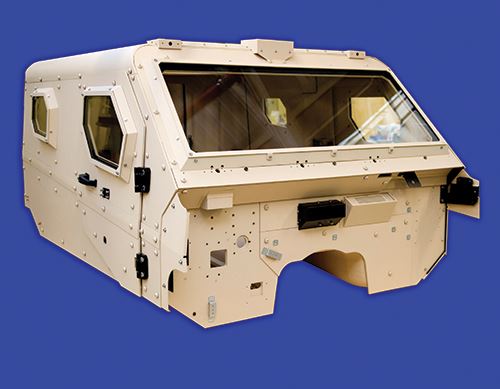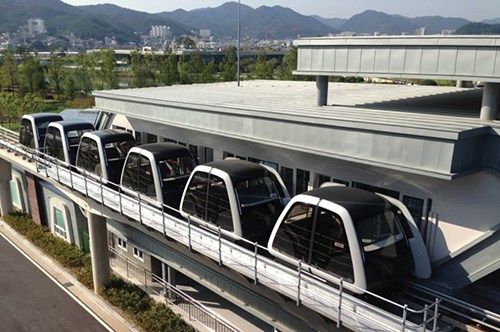Armored-vehicle and rapid-transit pods
Composite crew/passenger compartments drop vehicle weight but boost functionality.
Drawing on 40 years of materials and engineering expertise, Morgan Advanced Materials (Morgan, Windsor, UK) has designed and produced a custom crew compartment for Mumbai-based Tata Motors’ Light Armored Multipurpose Vehicle (LAMV) for the Indian Ministry of Defense. The composite-and-ceramic pod cuts vehicle weight by 1000 kg. The pod is 50% lighter than equivalent steel armor,
yet defeats a wide range of modern battlefield threats.
“This is a new variant on our proven CAMAC technology, which has been developed over the past 20 years and is used widely in the UK,” says lead engineer Mike Sandercott. Ballistic-grade, fiber-reinforced thermoset composite panels in combination with a ceramic armor strike face enables a modular monocoque construction that permits users to easily upgrade or downgrade the vehicle’s armor as its threat environment changes. The prepreg panels are precision-molded in shapes to match individual vehicle configurations. “They are cured on composite tools and bonded with an aerospace-grade adhesive,” says Sandercott, “and though the technology is similar to that used on our aerospace and motorsports parts, the assemblies are very large.” For example, the LAMV crew compartment measures 2.5m long by 1.4m tall by 2.1m wide, roughly the same as that on the US military’s Humvee.
The bonding minimizes joint lines for a stronger structure and more repellent surface. He adds, “We encapsulate the ceramic strike face in a Morgan proprietary way to enable multi-hit capability, an improvement we’ve implemented in the LAMV.”
The blast and ballistic-resistant CAMAC monocoque pods provide customized armored composite crew compartments for reconnaissance, tactical and special forces vehicles. They are detachable and, thus, easily integrated into customer-produced chassis, and they also are easily modified. Meanwhile, the weight savings CAMAC offers enables transport of more gear and/or better fuel economy as well as less vehicle wear.
Morgan designs and manufactures composite structures for the aerospace, defense, medical, motorsports and transportation industries, including the recent composite pod for the Personal Rapid Transit (PRT) vehicle used in South Korea’s Suncheon Bay, a coastal wetland that requires a tourist transportation system with minimal environmental impact. Morgan was tasked by the pod’s designer to develop a one-piece, structural frame with an integrated, 9m-circumference door surround, which would be rigid, lightweight and flexible. Morgan developed advanced “blown tube” techniques to create hollow composites with integrated stiffening ribs, all molded in a single curing process. Drawing on this experience, Morgan recommended a carbon fiber core comprising woven materials structured in two directions, for flexibility and ease of surface finishing, and unidirectional materials, optimizing the structure for a range of load cases. The part was autoclave-cured using phenolic resin for fire resistance and is now part of the pod used to transport an estimated 3 million tourists annually.
Related Content
-
Materials & Processes: Fabrication methods
There are numerous methods for fabricating composite components. Selection of a method for a particular part, therefore, will depend on the materials, the part design and end-use or application. Here's a guide to selection.
-
The making of carbon fiber
A look at the process by which precursor becomes carbon fiber through a careful (and mostly proprietary) manipulation of temperature and tension.
-
Braskem demonstrates PP solutions using Weav3D composite lattice technology
Partnership combines Braskem’s polypropylene sheets with Weav3D Rebar for Plastics technology to address new structural, automotive applications requiring high-strength, lightweight material solutions.











.jpg;maxWidth=300;quality=90)







